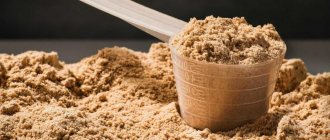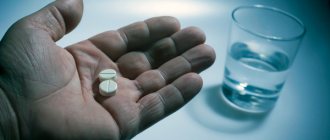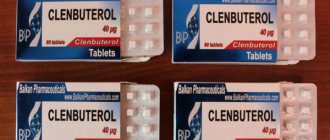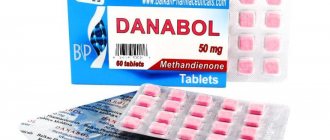Description
Creatine and phosphocreatine provide an intracellular, highly active phosphate buffer system necessary to maintain ATP levels in tissues with high energy demands. Most people get creatine through seafood and red meat. The liver, pancreas and kidneys also produce it in the human body.
This substance is, first of all, a storehouse of adenosine triphosphoric acid, which is released much faster than glucose, providing cell support during intense muscle loads. The body converts creatine to phosphocreatine and stores it in muscle cells. As a result, taking creatine orally improves athletic performance and increases muscle mass.
It can also be used to treat certain brain disorders, congestive heart failure and other conditions.
When is the best time to take creatine before or after a workout?
Scientific research suggests that there is little difference in whether you take creatine before or after a workout.
In one experiment, bodybuilders took 5 grams of creatine: one group immediately before and the other after strength training for 4 weeks. Muscle mass increased in both groups and there was no significant difference between both groups 13.
The same result was found in other studies 14.
Scientists, however, suggest that it is better to take creatine immediately AFTER your workout.
Another experiment showed that taking creatine immediately before or after a workout was significantly better at stimulating muscle growth than taking it long before the workout (in the morning, for example, if the workout was in the evening) 15.
What is creatine with transport system?
Creatine with Transport System is an advanced form of supplement designed to deliver creatine and glycogen regeneration, designed for multi-target effects on muscle maintenance, growth, and increased strength and performance. The main focus is to maximize creatine absorption to significantly increase strength and endurance, increase adenosine triphosphate levels, increase muscle glycogen and increase muscle cell volume thereby accelerating muscle growth. It consists of creatine monohydrate, creatine ethyl ester, taurine and L-glutamine for a multi-action effect.
Are there any benefits from creatine?
The benefits of creatine have also been questioned. This supplement is used by boxers, bodybuilders and other people who want to build muscle mass, and athletes who engage in other types of exercise. So, the supplement is not useless after all?
Creatine can primarily increase endurance, performance, and provide energy. It is due to this that athletes achieve results in shaping an ideal body, and also increase the effectiveness of training. True, the increase in mass is partly due to edema. As it turned out, the harm from taking creatine is still minimal, and many theories have already been refuted. This means it’s worth using the supplement. But at the same time you must strictly follow the scheme.
Effect on the body
When taking this supplement, phosphocreatine stores, which is a form of stored energy in cells, increase as it helps the body produce more ATP.
ATP is often referred to as the body's energy equivalent, and the more there is, the better the body can function during exercise and in everyday life.
Creatine's primary function in the body is to store high-energy phosphates in the form of phosphocreatine. During periods of physical stress, phosphocreatine releases energy to support muscle function. There are other parts of the body that can also benefit from it: the brain, bones, muscles and liver. The benefits of nitrogen containing carboxylic acid come from this exhaust system.
Creatine also helps build muscle in ways that:
- Improved Cell Signaling: May increase the conduction of signals between cells, which helps repair muscle and stimulate muscle growth.
- Increased anabolic hormones: After taking creatine, there is an increase in hormones such as IGF-1.
- Increased Cell Hydration: Increases water content in muscle cells, which may play a role in muscle growth.
- Reduced protein breakdown: May increase overall muscle mass by reducing muscle wastage.
- Lower myostatin levels: Elevated levels of the protein myostatin can slow or completely inhibit new muscle growth. Creatine can lower these levels, increasing growth potential.
IMPORTANT! Creatine gives muscles more energy and leads to changes in cell function that increase muscle growth.
Kinds
Before you go to a sports nutrition store, you need to understand what exactly you need for training. After all, there are many types of creatine. And each of them acts in its own way, has its own regimen and effectiveness. The benefits of each type of creatine for the body are assessed differently.
Monohydrate is the most popular and simplest type. The benefits and harms of creatine monohydrate have been revealed more than other types. It contains pure substance and water. It has pros and cons. One of the advantages is its relatively low price. However, its use causes side effects in the form of digestive tract disorders.
Citrate, phosphate, malate, tartrate - acids (citric, phosphate, lactic, tartaric) are added to these types, they help release energy. It is quickly absorbed and has more energy. The price for such pleasure is a little higher. And the concentration of creatine itself is lower.
Glutamine-taurine and magnesium contain additional magnesium and glutamine. The absorption of the main substance is facilitated and muscle strength increases. However, the dosage schedule is misleading.
HMB is a form that accelerates muscle growth, is quickly absorbed by the body and causes minimal harm to the digestive system. For this type you will have to pay the highest price.
Titrate, liquid creatine, effervescent tablets dissolve quickly in water. But their effectiveness is lower than other types.
Chewable one lasts longer. However, the price is not at all pleasing, and the concentration of creatine in these types is lower.
Instructions for use
There are many different types of creatine. If you look at the shelves, you can see creatine monohydrate, creatine ethyl ester, creatine hydrochloride, creatine AKG and others. The oldest form is creatine monohydrate.
Pharmacy drugs
Dosages of nitrogen-containing carboxylic acid should be calculated as follows:
Chronic heart failure
- 20 g daily for 5-10 days
Parkinson's disease
- 10 g every day
Gyratic atrophy
- 1.5 g daily
McArdle disease
- Initial: 150 mg/kg per day for 5 days, then 60 mg/kg per day
Muscular dystrophies
- 10 g daily
Amyotrophic lateral sclerosis (ALS, Lou Gehrig's disease)
- 10 g orally per day for 12-16 months
Idiopathic inflammatory myopathies
- 20 g per day for 8 days, then 3 g per day for 6 months.
Sports supplements
The purpose of creatine is to saturate the muscles with creatine stores. This can be achieved in several different ways, but it appears that an initial loading protocol followed by steady dosing is the optimal way to quickly achieve and maintain saturation levels.
Such a protocol would look like this: take approximately 0.3 g/kg/day for 5-7 days (approximately 20 g per day in 5 gram increments) and 3-5 g/day after the first 5-7 day period 2 ,3.
How is creatine beneficial for the human body?
Creatine is one of the most popular and effective supplements for enhancing physical performance.
It has also been studied for its other potential benefits, such as healthy aging and improved brain function.
May increase muscle size and strength
Taking a creatine supplement provides your muscles with extra energy, allowing you to exercise longer.
This extra energy has been shown to increase muscle size, strength and power. It may also reduce muscle fatigue and improve recovery (, ).
For example, taking this supplement has been shown to increase strength, endurance, and sprinting performance by 5–15% ().
Creatine is most effective for intense and repetitive sports and activities such as bodybuilding, martial arts, powerlifting, competitive track and field, soccer, hockey, and track and field sprinting (,).
May combat muscle loss in older adults
Creatine may help slow sarcopenia, the progressive loss of muscle strength and function that often occurs naturally with aging.
The disease is estimated to affect 5–13% of adults aged 60 years and older. It has been associated with disability, poor quality of life, and increased risk of death (, ,).
Several studies in older adults have shown that taking this supplement in combination with weight lifting can improve muscle health (, , ).
A review of studies found that taking creatine supplements helped older adults build muscle mass ().
In the review, participants took creatine supplements and performed resistance training 2–3 times per week for 7–52 weeks. As a result, they gained 1.4 kg more muscle mass than those who trained without taking creatine ().
Another review among older adults found similar results, noting that taking creatine may help improve the effectiveness of resistance training compared to resistance training alone ().
May improve brain function
Taking a creatine supplement has been shown to increase creatine levels in the brain by 5-15%, which may improve brain function. This is thought to occur by increasing the delivery of oxygen and energy to the brain (,).
A review of 6 studies involving 281 healthy people looked at the effects of creatine supplementation on certain aspects of brain function ().
It has been found that taking 5–20 grams per day for a period of 5 days to 6 weeks can improve short-term memory and intelligence ().
Some people suggest that taking these supplements may slow the cognitive decline associated with neurodegenerative diseases such as Parkinson's and Huntington's disease. However, human studies have failed to find any beneficial effects (,).
Summary:
In addition to improving physical performance, creatine may help older adults maintain brain health and maintain and build muscle mass.
Side effects
Several adverse reactions have been reported in clinical studies in patients with neurological or muscular disorders or in healthy subjects.
There are concerns about kidney and liver toxicity; There is no clear evidence of safety and caution is warranted.
Reported adverse reactions among athletes include dehydration, electrolyte imbalance, and muscle cramps. Minor GI disturbances (diarrhea, GI pain, nausea), dizziness and short-term weight loss have also been reported. The safety of creatine in children has not been established.
Possible side effects are listed below:
- It changes the body's water content by introducing additional water into muscle cells. Therefore, it may be assumed that creatine causes dehydration. However, this shift in water content is quite small.
- People suffering from kidney problems should avoid creatine. However, it is possible to take a creatine supplement again, after consulting with your doctor, if there are favorable treatment results.
- Without getting enough fluid, muscle cramps may occur, as creatine takes water from the internal organs, and this causes stomach discomfort. This can be easily corrected by increasing your daily water intake.
- Weight gain. This occurs in part due to the retention and accumulation of water in the tissues. However, unlike what the vast majority think, said fluid accumulation is part of how creatine works in the body, and it also occurs at the intramuscular level.
How does the substance affect a person?
The compound is widely used by athletes with different training experience and in different sports (from bodybuilding to sprinting). This supplement is suitable for those whose activities involve high effort and short-term stress.
The product is needed for:
- increasing overall muscle strength and volume;
- activation of performance;
- accumulation of energy reserves for intensive training;
- rapid recovery process after exercise.
Important! Creatine helps to accumulate the necessary energy in the muscles and realize the athletic potential of the athlete. To achieve noticeable results, it is necessary to use the supplement in courses (continuous use will reduce the production of your own creatine within the body).
Compatibility
Below we will discuss the compatibility of adenosine triphosphoric acid, which often raises questions.
Caffeinated
Combination with caffeine may partially inhibit the effects of creatine. One reason could be that caffeine causes dehydration since it is a diuretic, which is exactly the opposite of the effects of this supplement.
With alcohol
Not recommended, as alcohol negates the effectiveness of adenosine triphosphoric acid, and there is a risk of swelling of the limbs, cramps and stomach upset.
With other sports supplements
Acceptable to use.
With medications
As with any diet or eating regimen, it is always recommended to seek the advice of a physician. You should also avoid creatine supplements if you are taking any medications that affect liver or kidney function. Such medications may include:
Cyclosporine, aminoglycosides, gentamicin, tobramycin, anti-inflammatory drugs such as ibuprofen.
Symptoms of creatine overdose
Despite creatine's strong safety profile, taking doses higher than recommended is not necessary and may result in some minor side effects.
Bloating and flatulence
Creatine loading can lead to significant weight gain due to increased muscle mass and water absorption by the muscles. Although harmless, this weight gain can cause bloating.
For example, one study found that taking creatine supplements for 28 days, which also included a loading phase, increased participants' body weight by an average of 1.3 kg. This increase in body weight is attributed to both muscle growth and water retention ().
While not everyone experiences bloating when taking supplements, you can reduce this side effect by skipping the loading phase and taking a maintenance dose of 3-5 grams per day instead.
Discomfort in the stomach
Taking too much creatine at one time can cause stomach discomfort.
For example, in one study, athletes who took 10 grams of creatine per serving experienced diarrhea, stomach upset, and belching. Those who took 2–5 grams as a single dose did not report the same side effects ().
However, if you choose to follow a loading protocol, you can avoid these side effects by taking 20-25 grams of creatine, divided into 4-5 equal doses throughout the day.
There is no benefit to taking too much creatine
Taking too much creatine at once can cause stomach discomfort and bloating, which is a waste of money.
Once your muscles are fully saturated with creatine, it is recommended to take 3-5 grams or 30 mg/kg body weight per day to maintain optimal muscle supply.
Since this amount is enough to keep muscle creatine stores high, taking more than the recommended maintenance dose will cause your body to eliminate excess creatine through urine, since your body can only store a certain amount ().
Summary:
Although creatine is one of the safest dietary supplements available, excess consumption is wasteful and can cause bloating and stomach discomfort.
Creatine in sports
Creatine supplements increase phosphocreatine stores in muscles.
Phosphocreatine helps with the formation of new adenosine triphosphoric acid, which cells use for energy and all basic life functions.
During exercise, ATP is broken down into energy. The rate of Adenosine Triphosphate resynthesis limits the ability to consistently maintain maximum intensity - ATP is used faster than the body produces it. Creatine's direct role in production means it can significantly enhance high-intensity exercise performance.
A creatine supplement increases phosphocreatine stores, allowing you to obtain more energy to fuel your muscles during high-intensity exercise.
It can alter numerous cellular pathways that lead to muscle growth. For example, it promotes the formation of proteins that create new muscle fibers.
And also increase the level of IGF-1, a growth factor that helps increase muscle mass. In addition, creatine reduces levels of myostatin, a molecule responsible for stagnant muscle growth.
In the long term, it appears to promote muscle fiber growth by signaling key biological pathways and enhancing exercise performance in the gym.
In summary, creatine is known to improve a variety of factors, including:
- ballistic force,
- sprint,
- muscle endurance,
- fatigue resistance,
- muscle mass,
- recovery,
- brain performance.
Unlike supplements that are only effective for professional athletes, creatine provides benefits regardless of fitness level.
For girls
One interesting aspect of female physiology is that in women during pregnancy, certain hormones, such as IGF-1 and thyroid hormones, increase.
These hormones also increase the activity of creatine transport, which transports creatine to the muscles. It is believed that creatine is used by fetal cells in the production of myoblast cells, which ultimately become muscle tissue.
Creatine is delivered to the fetus directly through the placenta. Since the placenta is the main organ providing nutrition to the developing fetus, it uses a lot of energy and ATP. Conversely, lack of sufficient creatine, for example in a mother who does not consume creatine-rich foods such as red meat, can negatively affect fetal growth.
It is unknown whether the fetus itself can synthesize creatine, but the likelihood is that it cannot and must depend on maternal nutrition and delivery across the placenta.
For men
Follow your doctor's recommendations. About 1-2% of muscle creatine is converted to creatinine in men. In addition, eating well-cooked meat can increase creatinine levels (heat breaks down the creatine found in meat), so you can engage in intense exercise. It is also worth considering that the dosage of this supplement is higher in men due to greater muscle mass.
This article contains all the important questions with key answers regarding this supplement and the active ingredient itself.
Besides protein, this supplement is one of the most used by athletes to enhance athletic performance or improve physical fitness.
How to take creatine
In order for the result to be noticeable, you need to know how to use the supplement correctly. Many people make mistakes at the beginning of their journey. But it’s better to find out everything in advance so as not to play with your health.
The approximate daily norm is 2-5 grams. The substance is mixed with carbohydrates. Many people make the mistake of taking it before training. Experts have found that it would be more correct to do this after exercise.
The powder is poorly soluble in water. Crystals are often used this way: take the required dose into your mouth and wash it down with water. But this is not very convenient. A blender and shaker come to the rescue.
Attention! The quantity cannot be determined visually. Doses are very small, it is better to use a kitchen scale. It is worth noting that not all types are consumed equally
For some, an individual dosage regimen is determined. Otherwise, creatine in sports will bring not only benefits, but also harm. There are two schemes for using monohydrate:
It is worth noting that not all types are used equally. For some, an individual dosage regimen is determined. Otherwise, creatine in sports will bring not only benefits, but also harm. There are two schemes for using monohydrate:
- 4 times a day, 5 grams in sweetened water. Later, 5-10 grams in two doses.
- 10 grams in two doses.
It is important to increase the amount of fluid you drink while taking supplements. Every 5 grams – half a liter of water











